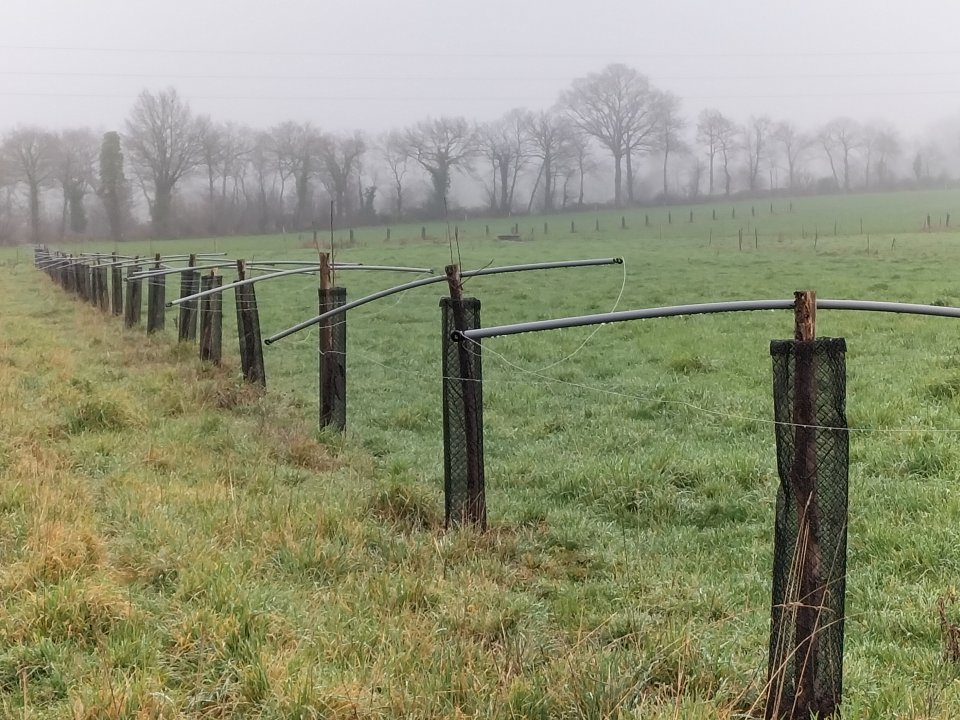
The joint agricultural grouping (GAEC) Lait’spérance has been labelled as having converted to organic farming and has a herd of 110 Phrim Hostein dairy cows and 70 heifers for milk production, the farm’s main activity. Today, the farm is facing problems of soil erosion and repeated droughts, causing yield losses and discomfort for the herd in summer. By reintroducing trees into the farm, the issue is to provide a safe haven for biodiversity while ensuring that the farm is managed in a more sustainable way. The planting of tall trees and fodder thickets in rows will both enable shade to be provided for the animals and provide a complementary and diversified source of fodder, based on regular pruning and controlled grazing. They will also have an innovative function, enabling them to produce ramial chipped wood (RCW). Once chipped and spread on the soil, it will encourage natural soil regeneration by reconstituting forest humus. The wood chips can also be used as mulch before being returned to the plots. The total surface area of the project is 18.8 ha
- For adapting to climate change : limiting drought and soil erosion.
- For biodiversity : offering a refuge for biodiversity and regenerating soil life by reintroducing trees to grazing land.
- For the local area : strengthening the long-term economic sustainability of the farm.
Begun in 2020, the work consisted in :
- Planting 447 melliferous species of tall trees at 6-metre intervals on a linear grass strip 2682 metres long and one metre wide. Between two rows of trees, the cultivated or grazing area is 24m wide on the first plot and 36m wide on the second, enabling favourable conditions for reintroducing biodiversity to the plots.
- Planting 1,005 fodder trees every metre.
- During the winter of 2020-2021 : planting 266 tall agroforestry trees, covering an area of 8.8 ha.
In addition to the Nature 2050 developments, an additional one-week participatory operation to plant standard trees over 34 ha.
BENEFITS REGARDING TARGETED ADAPTATION ISSUES
- Improving the resilience of the farm (to drought, flooding, frost, etc).
OTHER BENEFITS
- Reducing climate change by encouraging carbon sequestration.
- Reducing soil erosion and soil leaching on sloping land.
- Improving shade and the windbreak effect on the farm.
- Creating cool islands.
BENEFITS FOR BIODIVERSITY
- Increased diversity of plant species and habitats favourable to biodiversity.
- Improved well-being for the herd.
- Encouraging natural soil regeneration through the use of ramial chipped wood (RCW).
- Recreating a pleasant, wooded landscape for residents and visitors alike.
- Raising awareness of the benefits of agroforestry among neighbouring farms.
- Promoting local production of ramial chipped wood (RCW).
- Increase infiltration / Water storage
- Reduce drought risk
- Reduce flood risk
- Reducing temperature at meso or micro scale
- Increase Biodiversity
BENEFITS REGARDING TARGETED ADAPTATION ISSUES
- Improving the resilience of the farm (to drought, flooding, frost, etc). OTHER BENEFITS
- Reducing climate change by encouraging carbon sequestration.
- Reducing soil erosion and soil leaching on sloping land.
- Improving shade and the windbreak effect on the farm.
- Creating cool islands.
BENEFITS FOR BIODIVERSITY
- Increased diversity of plant species and habitats favourable to biodiversity.
- Improved well-being for the herd.
- Encouraging natural soil regeneration through the use of ramial chipped wood (RCW)
- Nature 2050 Programme – CDC Biodiversité : 20 000 €
- Department of Ille-et-Vilaine : 13 709 €
- Lactalis : 1 266 € Total budget : 34 975 €
In addition, the cost of maintaining and monitoring the project until 2050 will be covered by GAEC Laitspérance and CDC Biodiversité.
Monsieur Régis Badie et Madame Martine Blin martine.blin35@gmail.com
Nature 2050 – Programme & Fonds
nature2050@cdc-biodiversite.fr
- 2. Zero Hunger
- 13. Climate Action
- 15. Life On Land
